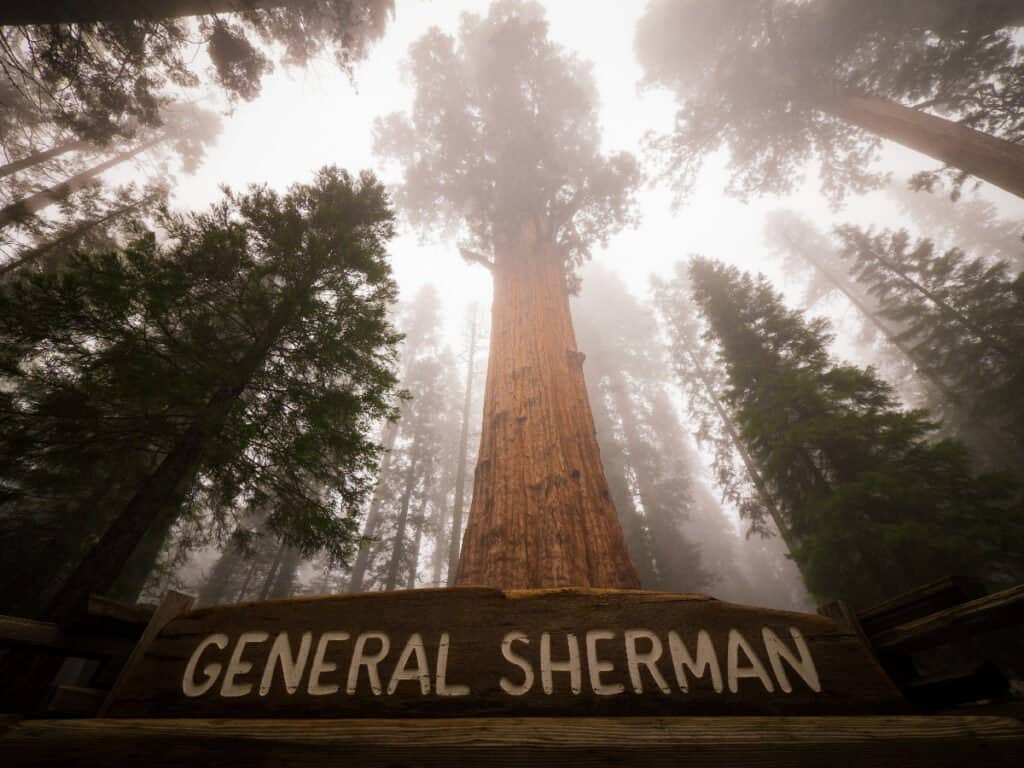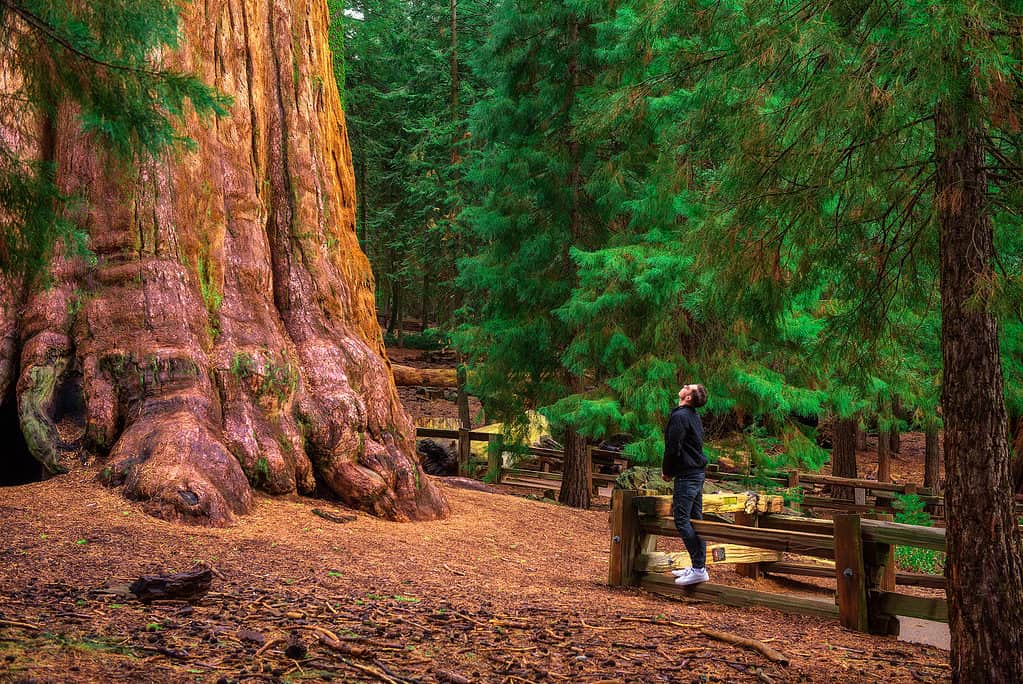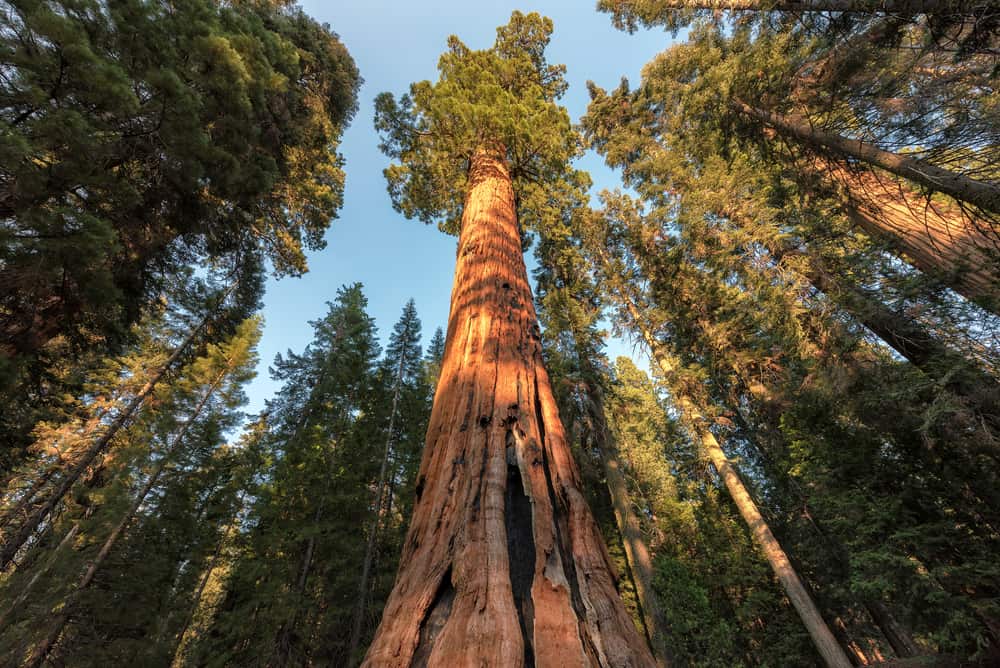According to its volume, the General Sherman Tree is the biggest tree in the world. Its base measures more than 36 feet in circumference and this tree is a whopping 275 feet tall. Sequoia trunks are quite broad at the top.
The Sherman Tree has a circumference of 17.5 feet at 60 feet above the base. While there are other trees in Sequoia & Kings Canyon National Parks that are towering and plenty wide, none of them weighs or is as wide as this behemoth.
“I took a walk in the woods and came out taller than the trees.” -Henry David Thoreau
Each year, it grows enough wood to create a new tree that is 60 feet tall. If you’re having trouble understanding the scale, you’re not alone. One of General Sherman’s branches has a diameter of about 7 feet. That dwarfs the majority of the plants east of the Mississippi River in size.
Let’s learn all about this gorgeous natural oddity that attracts visitors from all over the world!
History Of The General Sherman Tree
The General Sherman Tree, the largest known live single-stem tree on earth, is situated in Sequoia National Park. It is estimated that the tree is 2,300–2,700 years old. How was the name “General Sherman Tree” chosen?
What a fascinating tale! The tree is thought to have been found in 1879 by James Wolverton, a cowboy and fur trapper. James had never seen a tree as large as that one. He had previously served as a lieutenant in the 9th Indiana Calvary under General William Tecumseh Sherman. So he made the decision to give his commanding officer’s name to the tree.
The Plot Thickens
The story starts to get fascinating at this point. The Kaweah Colony, a socialist utopian society, investigated the region in 1884. For logging purposes, they were searching for trees. They found this enormous tree and named it Karl Marx in honor of the man who created communism.
Soldiers were sent to the region after the Sequoia National Park was established in 1890. They discovered these Kaweah Colonists and drove them out. Did the military give the tree a new name?
The only supporting documentation was a park guidebook that was originally released in 1921. James Wolverton and General Sherman Tree are the subjects of the guide’s narrative. This is the initial account of the Wolverton Story that has been published.
42 years after the reported occurrence, it suddenly materialized. As a result, it’s challenging to determine whether the report is accurate.

The General Sherman Tree is estimated to be 2,300–2,700 years old.
©zdenekkounovsky/Shutterstock.com
Where Is the Largest Sequoia Tree In The World Located On A Map?
The largest Sequoia tree in the world can be found in Sequoia National Park in central California. The huge park is close to the Nevada border on the east and lies between the cities of Sacramento and Los Angeles.
Protection From Wildfires
The dry, combustible vegetation and climate of California are major factors in the state’s high rate of wildfires. Massive wildfires that can be disastrous to the environment and neighborhoods across the state occur in California almost every year.
Because of property loss, poor air quality, intense heat, and other effects, these fires routinely and unfortunately force California residents to leave their homes. The state goes above and beyond to keep people… and trees as safe as possible.
September in the Golden State saw the KNP Complex Fire, a lightning-caused wildfire, move upslope toward Giant Forest, burning the General Sherman Tree, one of many giant sequoias covered in a protective aluminum coating.
Despite the fact that giant sequoias are fire-dependent and can endure the heat of modest fires because of their dense, insulating bark, more serious fires in the past six years have injured or killed numerous enormous sequoias.
In order to avoid burning through tree bases and igniting sensitive fire scars, which are indications of the numerous prior fires that these trees have withstood, extra measures were taken.
Firefighters noticed that wildfire activity was altered when it approached previously burned regions since Giant Forest had undergone numerous managed burns in recent years. Due to the fire’s moderate behavior, firefighters were able to construct a fireline close to the blaze in order to stop it from spreading into Giant Forest.
Firefighters ascended further around the base of the General Sherman Tree using wooden braces and then wrapped protective foil over the lower 10-15 feet of the tree. This substance, which was also used to shield buildings, reduced the possibility that a fire would spread to exposed places like old burn scars.

Severe fires in California over the past six years have injured or killed numerous enormous sequoias.
©iStock.com/Dimple Bhati
Visiting The World’s Largest Sequoia
From August through October, when weather conditions are typically pleasant and the weather is good, early in the morning is the ideal time to visit the General Sherman Tree. Winter is also a fantastic time to visit to take in the breathtaking juxtaposition of the snow and the red sequoias’ bark.
“A grove of giant redwoods or sequoias should be kept just as we keep a great and beautiful cathedral.” -Theodore Roosevelt
During this season, wildfires are still a significant risk, so ensure your arrangements are adaptable and that you have a backup plan in case they affect your trip.

The General Sherman Tree has a circumference of 17.5 feet at 60 feet above the base.
©Nick Fox/Shutterstock.com
Once You Arrive
The Sherman Tree is reached by two paths. Off Wolverton Road, there is parking for the Primary Trail; just observe the signage. Half a mile of the trail leads to the tree. It is paved and contains a few stairs.
You’ll reach the sequoia grove known as Giant Forest as you proceed. The natural history of giant sequoias is explained by exhibits placed along the path. The route back is inclined. Parking permits for people with disabilities are accepted in a tiny lot next to Generals Highway.
A little way in, a wheelchair-friendly trail takes you to the tree. During the shuttle season, you can use park shuttles to the accessible path if you don’t have a permit but can’t manage the Primary Trail. If you are physically capable, another option is to enter the Main Trail, proceed to the Sherman Tree, and then proceed to the shuttle station on the General’s Highway. You can avoid the incline by taking a shuttle back to where you parked.
The Sherman Tree’s thin roots are shielded by a fence. Please assist the park in preserving the tree by adhering to the paved pathway.

Sequoia trees typically live 3,000 years, making them the third longest-living species of tree.
©Lucky-photographer/Shutterstock.com
Why Are Sequoia Trees So Big?
Why can sequoia trees live for such a long time? They have the capacity to defend themselves from hazards posed by nature. Tannic acid, which can be found in trees’ sap, aids in the prevention of parasites, low-intensity burns, and fungal decay. It also serves as a fire deterrent.
These incredible trees can only reproduce by seeds. Nearly twenty years pass during which these seeds are enclosed in their pine cones without exposure to sunshine. Unbelievably, the heat produced by naturally produced forest fires aids in the dispersal of these seeds into the soil.
These trees generally have a longevity of 3,000 years, making them the third longest-living species of tree. These trees range in size from the smallest to the tallest, which stands at 26 stories.
Here is yet another intriguing truth. The first park that was genuinely established to save a living thing was Sequoia National Park. In reality, these enormous sequoia trees develop between 5,000 and 8,000 feet above sea level.
You might wonder how this is feasible. The mild winters at Sequoia provide the ideal natural environment for these amazing examples to develop and flourish. Sequoia National Park offers more than simply big trees to offer.
The tallest mountain in the lower 48 contiguous states is located in Sequoia. The tallest mountain in the contiguous United States is Mount Whitney. It is 14,505 feet above sea level. The west side of the mountain is situated in Sequoia National Park. The summit is situated at the southern end of the John Muir Trail.
The photo featured at the top of this post is © Simon Dannhauer/Shutterstock.com
Thank you for reading! Have some feedback for us? Contact the AZ Animals editorial team.







